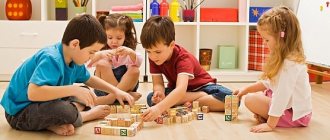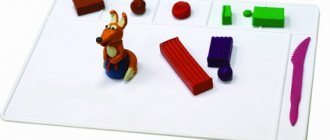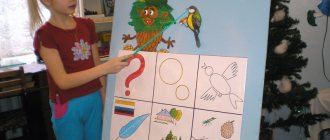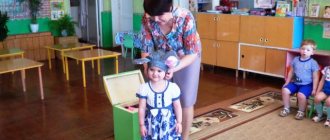“Games with rules - types, features of use in a group”
Traditionally, a game with rules appears in modern domestic pedagogy as a kind of antagonist of a plot game. Most practical teachers quite rightly believe that story-based play, or as it is often called, creative play, can take the form of a child’s free and independent activity. Another thing is playing with rules. This type of play is presented either as an ordered motor activity organized by an adult, during which children do not simply move randomly, but obey rules, the implementation of which is monitored by the teacher. Another popular form of games with rules in kindergarten is children playing with printed board games, such as dominoes, lotto and “goose”. In all of these games, the main attention of all participants, children and adults, is paid to the content of the game, its plot basis.
Games with rules represent a very extensive layer of activity for a preschool child. It is generally accepted that play with rules is of great importance for the physical, sensory and mental development of children. But, as a number of modern scientists note, the main developmental significance of a game with rules is associated with its specific characteristics. First of all, this is the development of independent normative regulation of behavior in children. If there is a rule (norm) that is mandatory for all participants, there is a need to monitor their implementation. In children, in their independent activities, conditions are created and the need arises for the implementation of such an important moral principle as justice.
A game with rules is characterized by competitive relationships between participants. The child has the opportunity to independently distinguish himself from other children, in accordance with simple and understandable criteria. For the development of a child, the fact of not only winning, but also losing is important. The experience of failure in a game contributes to the emergence in the child’s character of very important qualities (perseverance, the ability to achieve a given task, etc.), which will be useful to him in later life.
The whole life of a preschooler is connected with play. Mastering the things around him, relationships between people, understanding the meanings that social life carries, the work and responsibilities of adults - he gets acquainted with all this while playing, imagining himself in the role of mom, dad, and so on.
During the preschool period, the basic volitional qualities of the individual begin to form: perseverance and perseverance, determination, quick decision-making and bold implementation of them; self-control, that is, lack of vehemence when a conflict arises, independence, responsibility and discipline. Preschool age is a unique period in a child’s life, in which the foundations of personality are laid, the arbitrariness of mental processes is developed, creativity, activity and initiative develop. All these important qualities are formed in the process of carrying out the preschooler’s leading activity - in play. The most important role in the development of older preschoolers is played by those qualities and mental processes that are associated with the child’s ability to carry out complex, detailed play activities, primarily role-playing games with a plot, with the distribution of roles and rules. One of these qualities is will. Features of the development of will in preschool childhood are: the formation of goal setting, the emergence of struggle and subordination of motives, the emergence of internal control in behavior, the development of the ability to exert volition, speech planning of activities, encouraging adults and peers to carry out their own plans, arbitrariness in the sphere of movements, actions, and also cognitive processes and communication with adults.
Games for New Year's Eve
"Wavelength"
“Wavelength” is a game for communication and joint thinking.
For what: for communication - new topics will appear that are really interesting to discuss.
Price: 2890 ₽.
Number of people: from 2.
Age: from 10 years.
Difficulty: 2 out of 5.
What you need to do: divide into two teams, in each team the leader changes once a turn. The move takes about three minutes. The presenter receives a card with two antonyms (for example, on the left - cheap, on the right - expensive) and places an arrow on the scale in a random manner - including for himself. If the arrow is on the left side of the scale, it means that the presenter needs to come up with a cheap thing and name it to his team. For example, “doshirak”. The team must guess where exactly the leader's arrow lay: to the left or to the right, and how far from the edge. In our case, doshirak will be a super cheap thing, which means the team should put an arrow to the left.
It’s best to buy games with a cashback card
The easiest way to find cards with high cashback is on Sravni.ru
"Codenames"
“Codenames” is a detective game in which you need to guess the associations of the presenters.
Why: think and communicate.
Price: 1490 ₽.
Number of people: from 2.
Age: from 10 years.
Difficulty: 3 out of 5.
What you need to do: divide into two teams, in each team the leader changes once a turn. The walk takes about 10 minutes. The presenters must come up with association words for several cards of their team. The team needs to guess which cards (words) the presenter had in mind.
Advice
If the rules of the game interest you, but sound very complicated, look for a review of the board game on YouTube. They often post videos of the gameplay itself, where the company plays a game of the popular board game and at the same time explains the rules.
“Imaginarium. Good"
Drawings for “Imaginarium. Dobro” was prepared by children from orphanages and hospice patients; every 100 rubles from the purchase of this version of the game goes to charitable foundations.
Why: socialize and show intelligence and imagination, or just keep the kids occupied.
Price: 1499 ₽.
Number of people: from 4.
Age: from 6 years.
Difficulty: 1 out of 5.
What you need to do: voice an association with your card that most players will understand and guess which card it originally belongs to. The drawings are specially made so that there are no unambiguous interpretations.
"Twister"
Twister is a simple, fun and inexpensive game.
Why: keep the kids busy, shake themselves up and show miracles of flexibility and strength.
Cost: from 390 ₽.
Number of people: from 2.
Age: from 4 years.
Difficulty: 1 out of 5.
What needs to be done: the leader should turn the arrow and command which color circles to place their hand or foot on. Players must obey the leader and not fall. Whoever fell lost.
"Equivoca"
“Equivocs” is a simple, exciting game where you can explain words not only with gestures, but also through drawings, data sheets and figures sculpted from plasticine.
Why: keep yourself and your children busy, laugh and communicate.
Cost: mini version - 590 ₽; full set - 1850 ₽. A simplified alternative is “Charades”, 105 ₽.
Number of people: from 2.
Age: from 10 years.
Difficulty: 2 out of 5.
What you need to do: explain or guess words, movie names, brands or sayings. You need to explain in words, gestures, drawings or using plasticine.
Advice
Any game can be bought at a good discount, for example on Avito. Sometimes you can even find new options on ad sites - it happens that someone received the game as a gift, but was too lazy to understand it, so he decided to sell it.
"Emotional intellect"
Emotional Intelligence is a simple creative game for those who want to develop their sense of empathy or just have fun.
Why: practice acting skills, experience different emotions and gain new impressions.
Price: 1890 ₽.
Number of people: from 2.
Age: from 7 years.
Difficulty: 1 out of 5.
What you need to do: the game mechanism is similar to Imaginarium, but it creates a more lively atmosphere. The presenter needs to experience the emotion from his card so that the players guess his card among several others.
"500 Evil Cards"
The creators describe this game as “evil, vulgar and funny.”
Why: relax, laugh with friends at a feast.
Price: 1499 ₽.
Number of people: from 3.
Age: from 18 years.
Difficulty: 1 out of 5.
What to do: The presenter reads a sentence with a few words missing, for example, “How to stop relying on luck and relying on ___.” Players choose the best answer from their cards and give it to the presenter. He reads everything out loud and chooses the funniest option.
20 New Year gifts for playing Secret Santa up to 1500 ₽
Read on topic
Where to get an outfit for the New Year and save money - 7 ideas
Read on topic
UNO or "Svintus"
UNO is one of the best card games that has been tested over the years.
Why: keep the kids busy and have fun yourself.
Cost: from 199 ₽ or from 390 ₽.
Number of people: from 2.
Age: from 5 years.
Difficulty: 2 out of 5.
What you need to do: get rid of your cards faster than your opponents. Everyone lays out the cards one by one, choosing the same color or value as the previous one. A version for advanced UNO players or those who are already tired of it is “Svintus” (costs from 390 ₽). The basic rules are the same, but there are additional action cards that make the game more challenging. For example, after the “quiet hryun” everyone should be silent for one turn, and after the “where hands grow from” card, they should build huts from cards for speed.
"Jackal"
In the Jackal game, one game is not like the other, because each time the players lay out the field in a random order.
Why: keep the kids busy and have fun yourself.
Price: 1790 ₽.
Number of persons: 2–4.
Age: from 6 years.
Difficulty: 2 out of 5.
What you need to do: get as many coins as possible. Nobody knows where exactly the coins are. The playing field is laid out in random order each time, the cards are face down. The pirate gets off his ship and opens a card, there could be a coin, an arrow to continue moving, or even an ogre. One adventure, that is, one game, lasts 40–60 minutes. If you like “Jackal,” try a game similar in mechanics—with a random field, but for five participants—called “Zombies in the House.” It costs a little cheaper - 1490 ₽.
"Nature" games
There are three that genetically replace each other and coexist throughout life: Play, study and work. They differ in the final result (product of activity), organization, and motivational characteristics.
Work is the main type of human activity. The end result of labor is the creation of a socially significant product. It could be a crop grown by a collective farmer, steel smelted by a steelmaker, a scientific discovery by a scientist, a lesson from a teacher.
The game does not produce a socially significant product. It is in the game that the formation of a person as a subject of activity begins, and this is a great and enduring value.
In the mental development of a child, play serves, first of all, as a means of coping with the world of adults. In it, the child assimilates the objective world of adults at the achieved level of mental development. The game situation includes substitutions (instead of people there is a doll), simplifications (for example, the external side of receiving guests is played out). Thus, in the game, reality is crudely imitated, which for the first time allows the child to become a subject of activity.
The game is freely organized and not regulated. No one can oblige a child to play board games from 10 to 11 o’clock, and after 11 o’clock to play mother-daughter games. The game can be organized, but he himself must accept this offer. This does not mean that the child should not have a strict daily routine. You should indicate the time of sleep, meals, walks, games and activities. But the content of the game, the child’s participation in it, and the end of the game are difficult to regulate. The child himself moves from one game to another.
Various types of activities complement each other, coexist, and interpenetrate. In kindergarten, a preschooler not only plays, but also learns to play and draw. The schoolboy plays with pleasure after school.
Game moments have been successfully introduced into the organization of the lesson. Lessons with elements of game situations captivate the student. The game is an imaginary journey through a map of our country or a map of the world in geography lessons, when students talk about what they “see” based on their imagination. Students enjoy taking on playful roles - in foreign language classes: teacher, guide, salesperson - in the role of active language acquisition.
An employee not only works, he also studies (at night school, technical school, college, or engages in self-education). He can play chess and participate in other sports games.
Although activities do not exist in isolation, they have different meanings at different stages of a person's life. Before a child enters school, the leading activity is play.
When we analyze play as an activity, we must first analyze its nature. In foreign psychological literature, theories of play are widely used, according to which a child’s play releases the innate biological need for activity, which is inherent in both animals and people. They try to connect the development of children's play with the corresponding stages in the development of human society. Interest in playing in the sand, digging holes, stages of growing bread, playing with animals - animal husbandry, etc.
Games according to rules are widespread in the lives of schoolchildren and adults. By playing sports, solving crosswords and other games that require mental stress, a person switches to another type of activity, increases mental and physical strength and receives emotional release.
Being the main activity of preschoolers, play does not exclude other activities. At the age of three or four years, the child is introduced to self-care. He must wash himself, get dressed, put away his toys. At 5-6 years old, the child’s responsibilities include caring for house plants, helping elders clean the room, etc. In kindergarten, children are happy to be on duty in the dining room, in the living corner and in the playroom.









